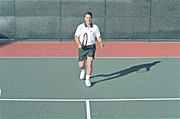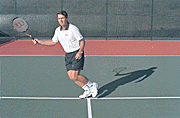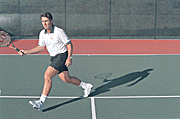|
TennisOne Lessons

The Split Step -
How to Cut Quickly to the Ball
Jim McLennan, Senior Editor, TennisONE
To see the animation of the split step, forehand,
click here.
To see the animation of the split step, backhand, click
here.
Watch a professional match on TV and look for the following.
Instead of watching Sampras hit and then watching Becker reply, just watch
Pete during the entire point. Interestingly, he splits his feet each and
every time Boris hits the ball. Further, he times the split to the exact
moment when Boris hits. Finally, he times his split so his reaction (cut)
to the forehand or backhand occurs immediately after he lands.
The split step is a dynamic move that transitions
us from a stationary or running position to the ready position in the wink
of an eye. Let's say your opponent pulls you
wide to your forehand side. After returning his shot (hopefully), you recover
by side-stepping towards the center. You transition out of your side-step
motion and prepare yourself for your opponent's next shot by split stepping
just as he hits the ball. When you serve and run to the net to hit the first
volley, you must transition out of your run into a ready position that will
enable you to move in either direction to hit the volley--and to move under
control. When you fail to split step,you commit the tennis faux pas
of running through your volley, which usually means you are going to ram
your volley into the net or bash it way out of court.
In this lesson, we'll be focusing on executing the split
step while you are serving and volleying. But to see how this applies from
a stationary position, see Monty Basnyat's tip.
  In the photos here, I am moving forward towards the service line,
where most first volleys are hit. Note how my feet are underneath me as
I run quickly to the net, but that my stance suddenly widens as I execute
the split step. In the photos here, I am moving forward towards the service line,
where most first volleys are hit. Note how my feet are underneath me as
I run quickly to the net, but that my stance suddenly widens as I execute
the split step.
  The first step after the split is always under and never out or
across. Known as a sprinter's start, a floating
pivot, or a gravity turn, the right foot moves slightly left and then sharply
pushes the subsequent crossover step. The strings of the racquet, the stenciled
"W," face the ball immediately after the split. The momentum towards
the ball continues after the split, in spite of the cut. The first step after the split is always under and never out or
across. Known as a sprinter's start, a floating
pivot, or a gravity turn, the right foot moves slightly left and then sharply
pushes the subsequent crossover step. The strings of the racquet, the stenciled
"W," face the ball immediately after the split. The momentum towards
the ball continues after the split, in spite of the cut.
To see how the split step for the forehand looks,
click here.
To see how the split step for the backhand looks, click
here.
With reference to the professional game, McEnroe and Edberg
were masters of the split step when taking the net. Moving forward quickly
as possible, they had the knack for cutting as wide as needed for most of
the passing shots they had to cover. As you practice your split step, remember
their excellent posture, their uncanny speed to the ball, and their ability
to finish off what seemed like winning passing shots.
One final note, a plug, refer to my Unit
Turn lesson to put together the concepts of the shoulder turn and the
split step. Note here how the split step has positioned my hips and shoulders
so I can both move to the ball as well as hit it.
Send email to the author
We encourage you to email your comments (pro, con, appreciative, whatever)
directly to the author. To send email to Jim McLennan, click
here.
Go To:
Other Footwork Lessons In Lessons Library
Top of Lessons Library
Back to TennisONE Home Page
What's New | Tennis
Lessons | Tennis
in Your Area
Tennis Fitness | Tennis
Products | Sponsors/Advertisers/Consultants
webmaster@tennisone.com
TennisONE© is a trademark of TennisONE© and SportsWeb ONE©.
Copyright© 1995. All rights reserved.
|